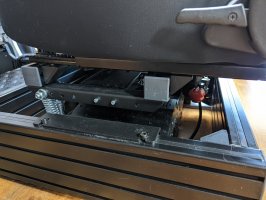Hi, I am trying to research the best motion system that allows me to use VR with motion compensation and is relatively silent. I am using regular OpenVR for iRacing + AMS 2 , but starting to use OpenXR mods for ACC and AC to get better performance.
My general perspective so far on the pro and cons on each solution. My two priorities are:
D-BOX D-BOX 4250i G3
Pros:
Pros:
Cons:
Qubic System QS-220-PL
Pros:
Cons:
PT Actuators Scorpion Super
Pros:
Cons:
RS MEGA+
Pros:
Based on my hard critera, the logical option seems to be Qubic System QS-220-PL, but curious what others experiences are.
My general perspective so far on the pro and cons on each solution. My two priorities are:
- Needs to work excellent with VR (OpenVR and OpenXR motion compensation)
- Should be relative silent to not shake a house too much. Some haptics are okay, but should be okay for residential setup
D-BOX D-BOX 4250i G3
Pros:
- Mature software, competitive advantage with its own SDK integration
- Motion + haptics combination is mature
- Most expensive option, but got much cheaper
- Very reliable
- Can be loud with haptics
- Not much travel if more motion is preferred for flight sim or rally - could be a limiting factor when using VR
- No VR compensation
Pros:
- More travel than D-BOX
- Few titles support, but support generally is good
- Good feeling for road texture
- Low response times
- Experienced US based company, reliable
- Cheaper option
Cons:
- No VR compensation
Qubic System QS-220-PL
Pros:
- A lot of travel, strong specs for latency and motion
- Experienced company (motion systems) with good support
- OpenVR and OpenXR VR motion compensation (based on my NLR Motion Platform V3 experience)
- Advertised as silent and home use friendly
Cons:
- Not a lot of third party reviews
PT Actuators Scorpion Super
Pros:
- A lot of travel
- Works with OpenVR motion compensation via SRS
- More affordable
Cons:
- No OpenXR motion compensation
- Travel might not be needed for regular road racing
- Increases height of rig
RS MEGA+
Pros:
- Cheap
- Open Protocol
- SRS supported
- Open VR motion compensation
- SFX rigs can have a 10 khz driver noise issue that is hard to address
- I assume there are support issues and that repairs would rely on DIY
- No OpenXR motion compensation
Based on my hard critera, the logical option seems to be Qubic System QS-220-PL, but curious what others experiences are.











